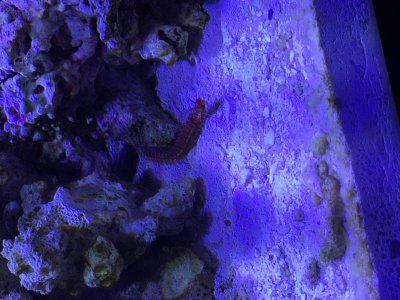You are using an out of date browser. It may not display this or other websites correctly.
You should upgrade or use an alternative browser.
You should upgrade or use an alternative browser.
Help: Can anyone tell me what this is??
- Thread starter giannetti23
- Start date
giannetti23
New member
How do I kill it? I tried long tweezers and the moment i get them in the water he darts under the live rock.
After some quick googling and reading a couple of forums on here it appears that people will take the rock out and do a fresh water dip and or pour club soda on the rock? Do some more research, but it seems like they are really difficult to trap and catch.
Hopefully someone else can chime in with more advice. Glad it's not in my tank, give me the heebie jeebies just looking at your picture :eek1:
Hopefully someone else can chime in with more advice. Glad it's not in my tank, give me the heebie jeebies just looking at your picture :eek1:
DubiousMaximus
New member
Bait an acclimatization box where the lid can be slid closed easily & wait
DubiousMaximus
New member
thats one nasty looking captive you have. Probably as bad as a polyclad imo
Here is an article on these not so lil worms in a public aquarium;
http://www.dailymail.co.uk/sciencet...rium-staff-mysterious-attacks-coral-reef.html
Here is an article on these not so lil worms in a public aquarium;
http://www.dailymail.co.uk/sciencet...rium-staff-mysterious-attacks-coral-reef.html
jraker
New member
you can try many different ways to get it out. you can try the bottle trap method, but i dont know how big the worm is and if it will fit in the bottle.
i have heard of the 'panty hose' method where you put some food in a panty hose. supposedly, the worm's bristles will get caught in the panty hose.
you can also try stunning it. go down in the middle of the night, and if you see it. shine a flashlight right at it. you can then proceed to try to get it out with some tongs.
i hope this helps, it really sucks to have that in a tank
i have heard of the 'panty hose' method where you put some food in a panty hose. supposedly, the worm's bristles will get caught in the panty hose.
you can also try stunning it. go down in the middle of the night, and if you see it. shine a flashlight right at it. you can then proceed to try to get it out with some tongs.
i hope this helps, it really sucks to have that in a tank
hotelbravo
Active member
i like the pvc or bottle trap method it really does seem to work wonders. speaking of wonders... im wondering why this is in the cephalopod section...
udiego
New member
Hello, I had one of those destroying my corals and eating my fish once. If this worms break they have the ability to grow another head and the problem continues. They don't really ever fully leave the rock cavity so any method above can potentially cause them to split. Unfortunately and as painful as it is, I recommend you find the rock he's hiding in, remove it and dip it in fresh water. The worm will dart out but be careful that no pieces stay behind. Hope this helps.
Similar threads
- Replies
- 0
- Views
- 62

